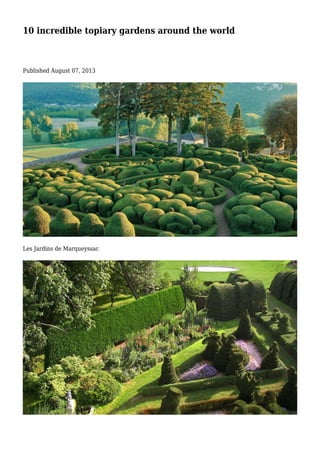10 incredible topiary gardens around the world
- 1. 10 incredible topiary gardens around the world Published August 07, 2013 Les Jardins de Marqueyssac
- 2. Ladew Gardens Staff Photos Longwood Gardens/L. Albee Topiary gardens are where lush greenery combines with structure and form for a magical result. Check out these amazing gardens, open to the public. 1. LEVENS HALL Located in England's famously picturesque Lake District, Levens Hall boasts the world's oldest topiary garden still surviving in its original design. Dating back to 1694, the topiaries reflect the late-17th-century taste for clipping trees and shrubs into abstract masses or geometric forms. Huge yew and beech hedges create garden rooms (state rooms, really), and parterres are punctuated with towering top-hatted shapes seeming to totter on a single trunk. The garden also includes an orchard, a nuttery for growing beechnuts and walnuts, and a bowling green. 2. DRUMMOND CASTLE Drummond Castle and grounds were established in Perthshire, Scotland, in 1490. The tower house remains largely intact, but the gardens have been substantially changed over the centuries. Today there is some back-and-forth over the authenticity of the grounds (restored or re-created?), but most agree that they represent a grand 17th-century Scottish garden. The parterre, with its low clipped embroidery hedges, is in the shape of a large St. Andrew's
- 3. cross--geometric topiary forms being all the rage in the latter part of the 1600s. The regimentation of the layout is leavened with the addition of leaning topiary trees that lend an impish, Harry Potter-ish charm. These tipsy towers accentuate the long views from the garden, across verdant fields to distant hillsides. 3. MARQUEYSSAC Les Jardins de Marqueyssac After you have eaten all the foie gras and truffles you can during your visit to the Périgord region of France, consider a postprandial visit to Marqueyssac. The original garden was created in the 19th century and enhanced when a new owner, Julien de Cerval, acquired the property and made it his life's work. In 1861, De Cerval began laying out a dreamy topiary garden on a hill high above the Dordogne River. He spent the next 30 years overseeing 150,000 boxwoods groomed to mimic the surrounding hills of the Dordogne Valley or, when viewed from above, the backs of grazing sheep. This might be the most relaxing garden in France. Even the garden's website evokes twilight thoughts of peaceful slumber: Gaze at the count-the-sheep topiaries, or just listen to crickets and snipping shears. 4. LADEW GARDENS
- 4. Ladew Gardens Staff Photos When you find yourself caught in the seemingly endless tedium of Interstate 95 around Baltimore, take an off-ramp to the wonderful topiary gardens created by Harvey S. Ladew. A bon vivant born during New York's Gilded Age and a famous cutup, Ladew (1887-1976) purchased a Maryland farm, later developed 22 acres of it for a garden, and then decided to do all the landscaping and garden planning himself. A sporting gent, Ladew often rode to the hounds during visits to England, which inspired his not-to-be-missed topiary hunting scenes complete with fox and hounds bounding across lawns and horses and riders clearing fences in pursuit. In another garden area, Ladew's huge oval swimming pool is surrounded by wavelike topiary hedges topped with green swimming swans. Ladew was able to infuse his rooted-to-the-earth sculptures with a sense of motion that is unique in this arena of garden design. 5. LONGWOOD GARDENS
- 5. Longwood Gardens/L. Albee Located 30 miles from Philadelphia, Longwood Gardens was deemed by Geoffrey Jellicoe, founding president of the International Federation of Landscape Architects, to be "one of the truly outstanding American estates." Established and organized largely by Pierre du Pont in the early 20th century, the property originally belonged to founder of the Province of Pennsylvania William Penn. Penn sold it to a fellow Quaker named George Peirce who shared his curiosity and reverence for plants and the natural world. The Peirce family established an arboretum there and when the land came up for sale in 1906, Du Pont purchased it largely to save the trees. After traveling the world and visiting many famous gardens, Du Pont settled down at Longwood to begin building his own extensive gardens. Influenced by European topiary art, he established a garden of yews clipped into geometric forms and the shapes of animals and even a table and chair. Today the garden contains more than 50 topiary trees. See all 10 gardens at Architectural Digest More From Architectural Digest Gorgeous Celebrity Pools Brooke Shields at Home in NYC Incredible High-Design Treehouses Best Celebrity Living Rooms




